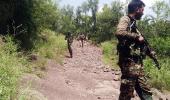The soldiers guarding the Line of Control in this north Kashmir area not only keep an eye on the hostile neighbour but have to battle a tough terrain, extreme climatic conditions, including about 15-20 feet of snow during winter which snaps links with rest of the country for at least four months.

And with the winter not far away, the battle is about to get tougher.
“It is a tough fight. Life in these terrains is very difficult,” a soldier guarding one of the posts in Keran Sector in Kupwara district of Jammu and Kashmir told PTI.
These Army posts -- some at the highest altitude of about 12,000 feet -- are the first line of defense against the intruders in these infamous, traditional routes of infiltration. These infiltration routes converge at the mighty Shamsabari range.
The range with its mighty peaks, rugged mountains, thick forests with dense vegetation, and several streams, poses a difficult challenge, to the forces, of both the kind – the nature as well as of the man.
“Apart from the topography, the weather here is very harsh, it is extreme. We have too much cold here when it snows. The snow can accumulate up to 20 feet and remain there for about three-four months,” an Army officer said.
The soldiers and officers of the Army as well as the posts cannot be identified for strategic reasons.
For the months of the winter, the forces at such posts or their base camps have to stock up the essentials as the road gets cut-off due to heavy snow. For those months, helicopters/ choppers are the only mode of transportation.
“The road, many bunkers and other infrastructure is not even visible when the snow accumulates. There are high-poles which act as markers for us in such situations when we have to move,” the officer said.
Notwithstanding the nature, the officer said, the duty to protect the motherland is the priority and has to be performed in any case.
“The duty at the forward post can sometimes stretch several hours especially if there is an input (terrorists movement),” he said.
While the infiltration has remained largely under control so far this year – helped by the ceasefire agreement in the February of 2021 – the possibility of Pakistan would return its old ways of making increased attempts to sneak more terrorists ahead of the winter.
The winter months – from November till February or even March – are difficult times for infiltration because of the heavy snow. The high-altitude areas in the valley receive heavy snowfall which can accumulate up to around 30 feet in many areas.
“There is always this apprehension, this possibility, that before the snow sets in, Pakistan may try to increase the infiltration,” officials in the security establishment said.
It has been happening over the years and there is no surety that it will not happen again, they added.
They, however, said, the counter-infiltration grid was strong and the security forces were alert to thwart any such designs.
“We are alert to any such situation. The AIOS (anti-infiltration obstacle system) is robust and we are keeping a close vigil especially on the known tracks (of infiltration),” they said.
The reiteration of the ceasefire agreement by the two armies has helped the army on this side to keep a check on infiltration, but the guard is not being let down.
“Yes, the ceasefire has helped. The Pakistani Army would usually try to provide a cover to the infiltrators by firing on our posts when there was no ceasefire. So, that is there. But, ceasefire or not, we have to be alert. We cannot take it for granted,” the officials said.
They said a multi-tier deployment was in place to stop infiltration -- some of it is physical, some electronic.
“It is a combination of man, machine and surveillance,” they said.
Explaining if further, they said apart from the LoC fence, known as the AIOS, there are integrated surveillance systems, including ground sensors, night vision devices, and CCTV cameras to support the robust deployment on the ground.
Of the 743-km long LoC in Jammu and Kashmir, about 350-km is in the Kashmir valley – 55-km of which is in the Keran Sector alone.
The officials said the infiltration numbers have witnessed a decline over the past few years.
In 2017, 419 infiltration attempts were made, followed by 328 in 2018, 216 in 2019, 99 in 2020 and 77 in 2021, respectively. This year also, the number is not high.
Six infiltration bids have been foiled in the Kashmir division so far this year.
Jammu and Kashmir police chief Dilbag Singh also said the infiltration along the LoC has decreased and was almost zero.
“There have been some attempts but they were crushed and foiled. A couple of infiltrations were successful also. The border grid is strong, it will be strengthened and made more stronger,” he had said on Friday.
However, the officials assert that intelligence inputs of about 250 terrorists waiting across the LoC in Kashmir at various launch pads to infiltrate were there.
“So, we cannot let our guard down,” they said.
Apart from the infiltration of terrorists into the valley, the Army has to watch out for other ‘enemy' – drugs.
Smuggling of drugs from across the border is on the rise and Pakistan is using it to fund terrorism in Kashmir, DGP Singh said.
“We are keeping a close eye on the smuggling of narcotics as well apart from infiltration of terrorists and arms and ammunition. The enemy has its ways, but we are firm and ever ready to defend our motherland,” the Army officer also stressed.










